- 1Fota Wildlife Park, Carrigtwohill, Ireland
- 2School of Biological, Earth and Environmental Sciences, University College Cork, Cork, Ireland
Citizen science is increasingly recognised as a useful approach to contribute to biodiversity awareness while generating data and creating meaningful interactions among citizens and professional scientists. In a number of countries, academic institutions have led the way in developing ladybird projects, incorporating citizen science, to increase distributional data on the species, as well as a greater understanding of ladybird ecology. The current research evaluates the role of citizen science campaigns in collecting biological distributional data in Ireland, using ladybirds as a case example, examining if citizen science records and the use of photographs can provide a valuable insight into our understanding of ladybird ecology. From April 2020 to June 2021, a citizen science programme engaged with the wider public, via social media networks to increase the number of ladybird records and assist in establishing national data baselines, since ladybird rcording is a relatively new phenomenon in Ireland. This case study finds that citizen science projects using social media can increase the number of records of ladybirds and provide useful information on species distribution patterns. There were a disproportionate number of records from areas of high human population, resulting in a bias towards urban centres. Photographs submitted by members of the public provided a limited amount of information on food plants but indicated that ladybirds are valued as a species of interest to the public. These images can also help to increase records of the less common species, especially as members of the public may not be able to easily distinguish between different species of ladybirds.
Introduction
The term ‘citizen science’ (or ‘community science’) has increasingly been featured in academic research over the last two decades and involves the participation of the public by collecting and providing data (Kruger and Shannon, 2000; Haklay, 2013; Ambrose-Oji et al., 2014; McKinley et al., 2017; Roche et al., 2021). It is evident from scientific literature that citizen science has been used in the tracking of environmental trends to increase numbers of biological records and therefore increase our understanding of ecological trends (Donnelly et al., 2014; Davis et al., 2018; Roche et al., 2021 ).
The data that can be collected by scientists depends on a range of factors, such as available funds, sample size and well-designed protocols (Gardiner et al., 2012; (Donnelly et al., 2014; (Bonney et al., 2016; Kosmala et al., 2016). Nevertheless, when few resources are available for research that requires data on the geographical distribution of species, citizen science is considered to be invaluable (Matutini et al., 2021), however, it has also been noted that in some cases, such as public outreach, citizen science projects can require lead-in time to gain momentum and awareness (Ferster et al., 2017). Citizen science, however, is a relatively new approach to dealing with data collection and scientific research. Geldman et al. (2016) recognised that there are tradeoffs in citizen science and that there are also spatial bias factors to consider. However, a growing body of publications suggest that accurate data can be produced for a diverse range of projects, if designed with a clear set of goals and appropriate methodologies (Kosmala et al., 2016).
Social media is an increasingly popular way of petitioning for records, offering free and open platforms (Mazumdar et al., 2018). Social media can impact the number of records submitted (Robson et al., 2013) by reaching a wider audience. Oliveira et al. (2021) examined the use of social media in citizen science projects and Roche et al. (2021) included “Irish Ladybirds” (the name of the social media page for this research) as one of the 42 citizen science projects in Ireland with over 1000 followers. Oliveira et al. (2021) highlighted the time required to set out the social media timeframes, posts, and analysis on the social media platforms but concluded that such platforms can be highly beneficial to biodiversity projects (Fota Wildlife Park, 2022). Furthermore, technological advances in smartphones, with good image capturing abilities, GPS co-ordinates are revolutionising citizen science and now enable records to be quickly shared (Mazumdar et al., 2018).
A number of studies have used citizen science approaches in ladybird research. These have included projects that have extended from the Americas to Europe and Africa ((Brown et al., 2007; Losey et al., 2007: Stals and Prinsloo, 2007; Steenberg and Harding, 2009; (Grez et al., 2016, Hiller and Haelewaters, 2019; Werenkraut et al., 2020; Angelidou et al., 2022). Citizen science has contributed to our knowledge on ladybirds—including new species records (Losey et al., 2007) and the spread of the globally invasive ladybird Harmonia axyridis (Stals and Prinsloo, 2007; (Roy et al., 2016; Hiller and Haelewaters, 2019; Werenkraut et al., 2020).
Recording of ladybirds on a national scale is relatively new in Ireland, and numbers of records have been increasing, greatly assisted by the establishment of the National Biodiversity Data Centre in 2007 (Roche et al., 2021). Datasets can be compared, by a system of cross-referencing data, with other data sources, linking to local weather at the time or recording, habitat types and the experience of the recorder ((Terry et al., 2020). The use of photographs can be invaluable for assessing relative abundances of rarer, less frequently recorded species, but also may reflect information on habitat associations ((Newcomer et al., 2019). However, the collection of data from photographs can also be influenced by patterns of human behaviour. Boakes et al. (2016) concluded that volunteers were often attracted towards particular schemes where they could identify species easily and where little effort was required.
In 2020–2021, we ran a citizen science programme in Ireland to increase the number of ladybird records, review distributional information, and evaluate if the collection of photo-records is a useful tool to gather information on the habitat and species present in Ireland.
Methods
The study was based upon promotions using two Facebook platforms: (i) Fota Wildlife Park (a highly interactive page of 157,000 likes) which covers wildlife species in the park and other projects that are managed by Fota Wildlife Park and (ii) the research project Facebook page Irish Ladybirds (5699 likes). The Irish Ladybird project was promoted between April 2020 to June 2021, and records collected by email. The Irish Ladybird social media Facebook page was regularly updated, at a minimum on a weekly basis, with regular posts and a photographic competition held between April and September 2020. Promotional posts were incorporated into the work of Fota Wildlife Park which comprised of single postings. Records were collected via two email accounts. Information requested from members of the public included: (a) location (postcode/address/geo-coordinates) and (b) photographs of the ladybirds that were observed. Urban locations were identified as towns and villages with a human population more than 1500 (Central Statistics Office, 2021a). The photographs were examined to identify ladybirds and to collect habitat information. Photographic information was classified using criteria in Table 1.

Table 1 Criteria used for assessment of photographs of ladybirds submitted by members of the public.
Results
A total of 924 records were submitted with 56% collected via the Irish Ladybirds Facebook page and 44% from the Fota Wildlife Facebook page ((Conrad and Hilchey, 2011). A total of 100 posts were posted on both Facebook platforms and from 2 to 16 posts per month (mean = 6.6, standard deviation = 4.1) with no significant relationship between the number or records and posts during the study period (r = -0.06516, p > 0.05). The largest number of people (38,000) viewed the original Facebook post on April 16, 2020. Social media engagement was enhanced by promotional activities as online posters encouraged the public to submit records of ladybirds in gardens and other local places. These were uploaded to the Irish Ladybird Facebook page on March 3, 2021, and consequently reached 11,300 people with 69 records submitted. To further encourage involvement a photo competition on the Irish Ladybirds Facebook page ran from April to September 2020 and elicited a total of 171 records.
Figures 1, 2 show the number of records submitted from areas where human population was less than 1500 and above 1500, respectively. The largest number of citizen science records were submitted from urban areas (>1500 human population) and furthermore from centres of high human populations (Dublin City and Cork City urban areas. The number of ladybird records submitted was highest in urban areas (> 1500 human population) (Figure 2). Note that out of the 924, total records, 28 records did not provide locality detail for mapping. The majority (84%) of records were submitted by one person for one location (Table 2). As a result, 685 people submitted records but only 16% of these submitted more than one record (Table 3). Monthly data indicate that records were higher in April, May, June, and July 2020 and for March and April 2021. The lowest numbers of records were submitted during the winter months (Figure 3).
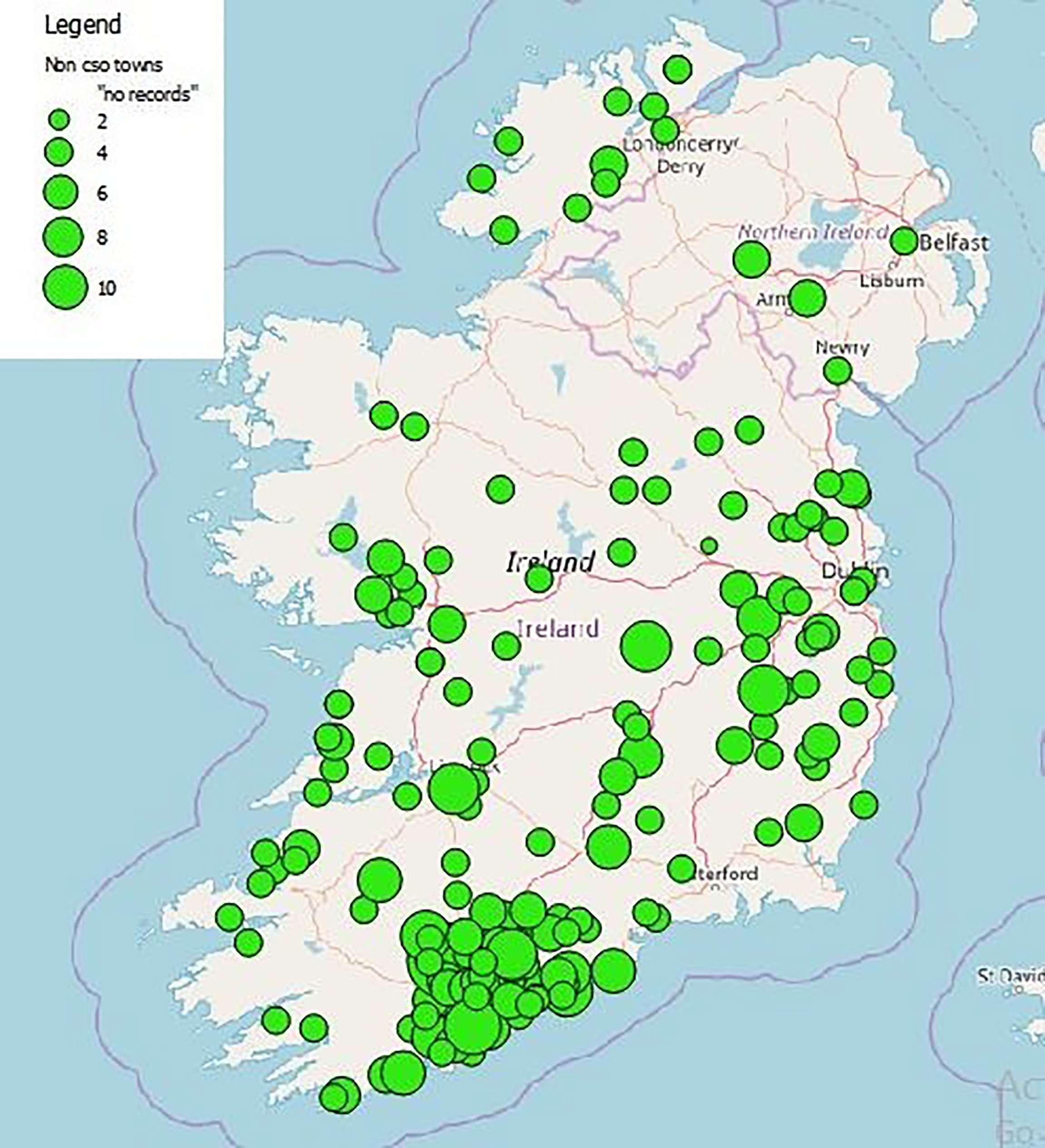
Figure 1 Ladybird records submitted at locations with human population less than 1500 (Central Statistics Office, 2021a). Circle size reflects the number of records (total n=290).
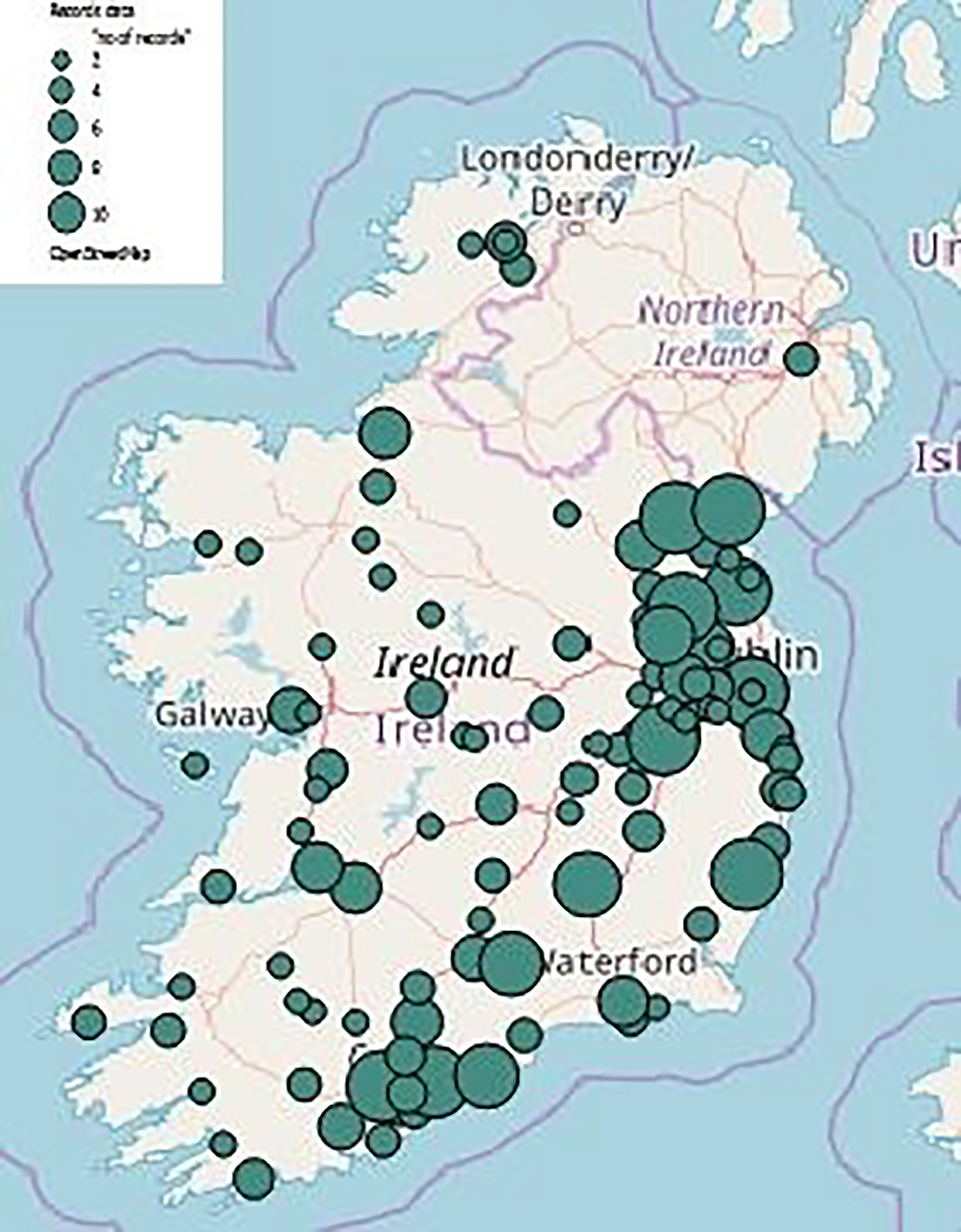
Figure 2 Ladybird records submitted at locations with human population greater than 1500 (Central Statistics Office, 2021a). Circle size reflects the number of records (total n=606).
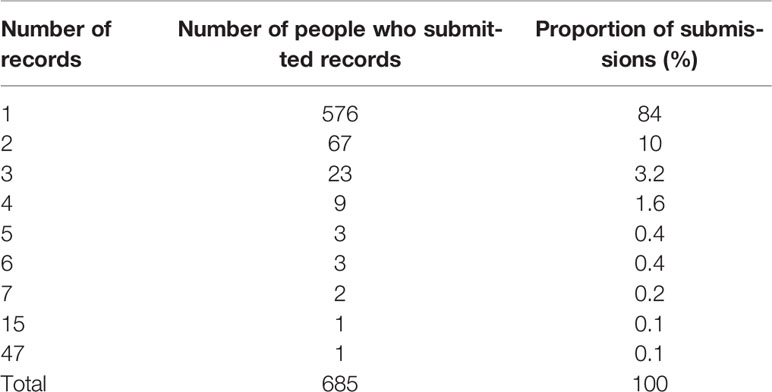
Table 2 Number of ladybird records, no of people who submitted records and proportions of submissions (n = 685).
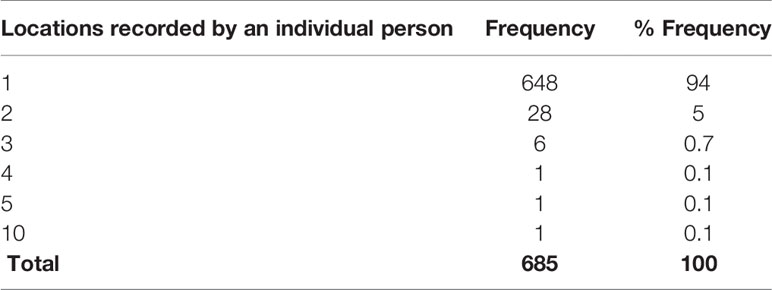
Table 3 Locations recorded by an individual person, frequency, and percentage of frequency (n = 685).
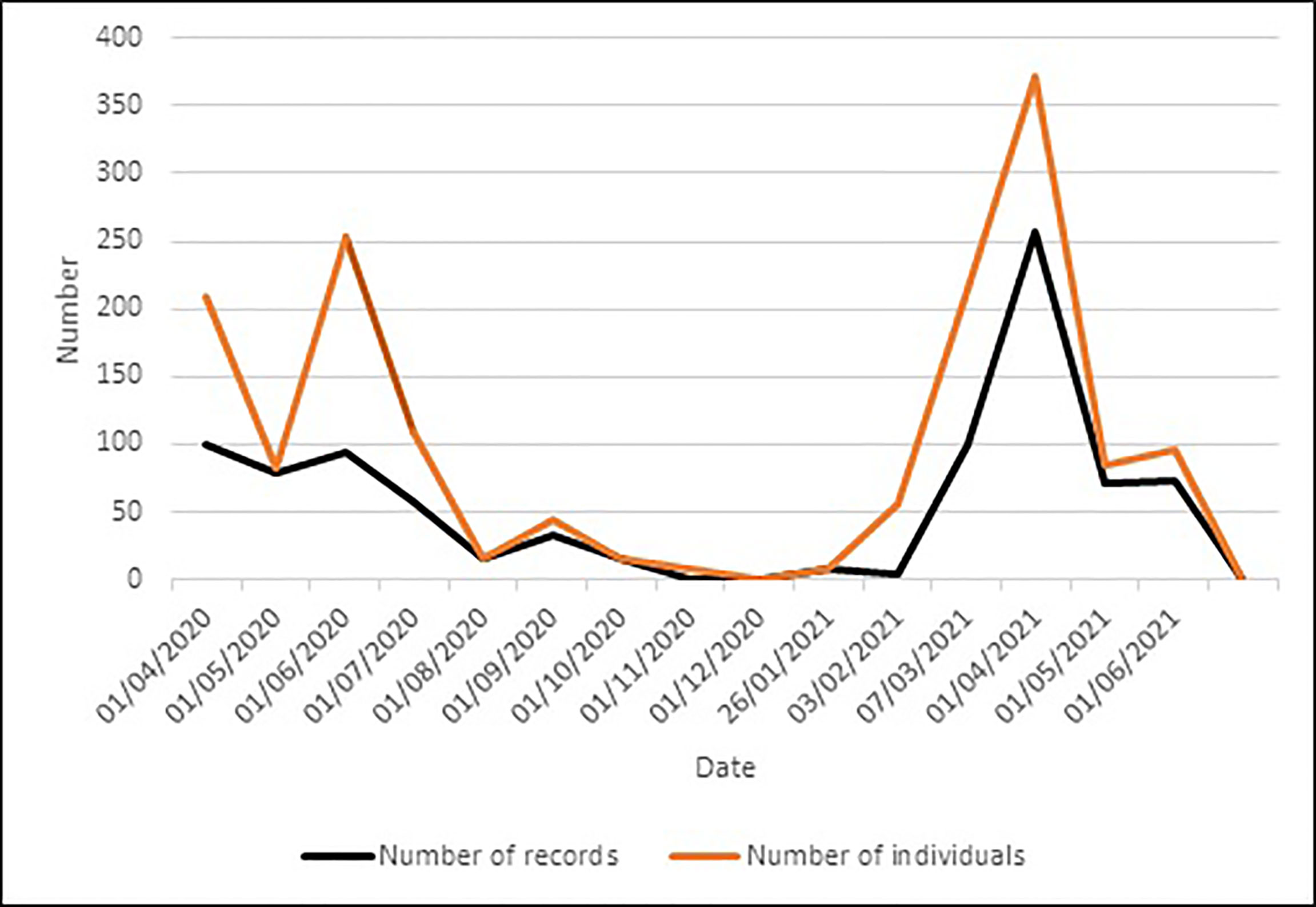
Figure 3 Number of records (n = 924) and number of individual ladybirds (n = 1591) recorded between April 2020 and June 2021 during our citizen science campaign in Ireland.
We developed criteria to classify photographs in terms of identification of species and substrate. The majority of photographs (88%) gave a clear image of the ladybird, allowing accurate species identification. Of all photographs, 20% showed the ladybird only, whereas 20% gave a reasonable view of the substrate and surroundings. Ladybirds were mostly recorded on plant substrates, including Poacea spp. (grasses), Urtica spp. (nettles), and dead wood. A total of 30% of plant substrates in the photographs could not be identified, due to lack of detail or to the fact that only the ladybird was visible with no detail of surroundings. There was a common trend for recorders to pick up ladybirds and photograph them on their hand or arm.
Eleven species of ladybird were recorded in the survey (Table 4) representing 45% of the Irish ladybird biota. The most recorded species was Coccinella septempunctata (n = 1264 individuals), followed by the invasive Harmonia axyridis (n = 122). Our work has contributed to the number of records of two poorly known species, Calvia quatuordecimguttata and Chilocorus renipustulatus (Figure 4). Between April 2020 and June 2021, we recorded 36 records for these two species compared to 69 records reported by the national data base. Most of the species submitted to this research were generalist species that have a broad niche and can adapt to many environmental conditions. Specialist ladybirds have a narrower niche, e.g., Chilocorus renipustulatus is most often found on deciduous trees (Roy et al., 2011).
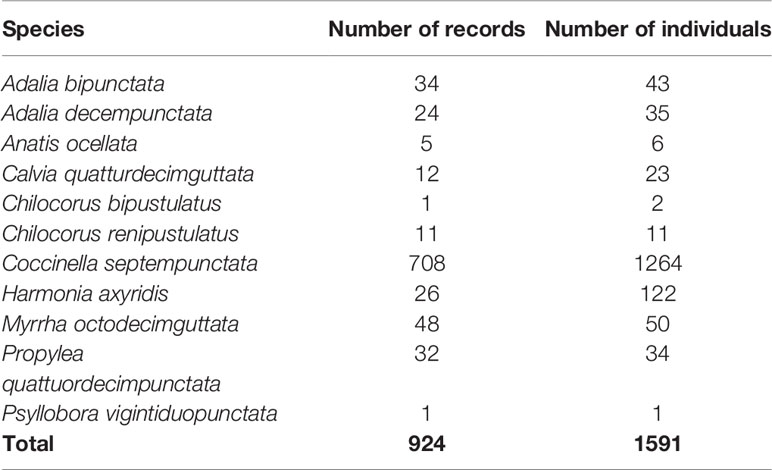
Table 4 Number of species and records of ladybirds recorded between April 2020 to June 2021 during our citizen science campaign in Ireland.
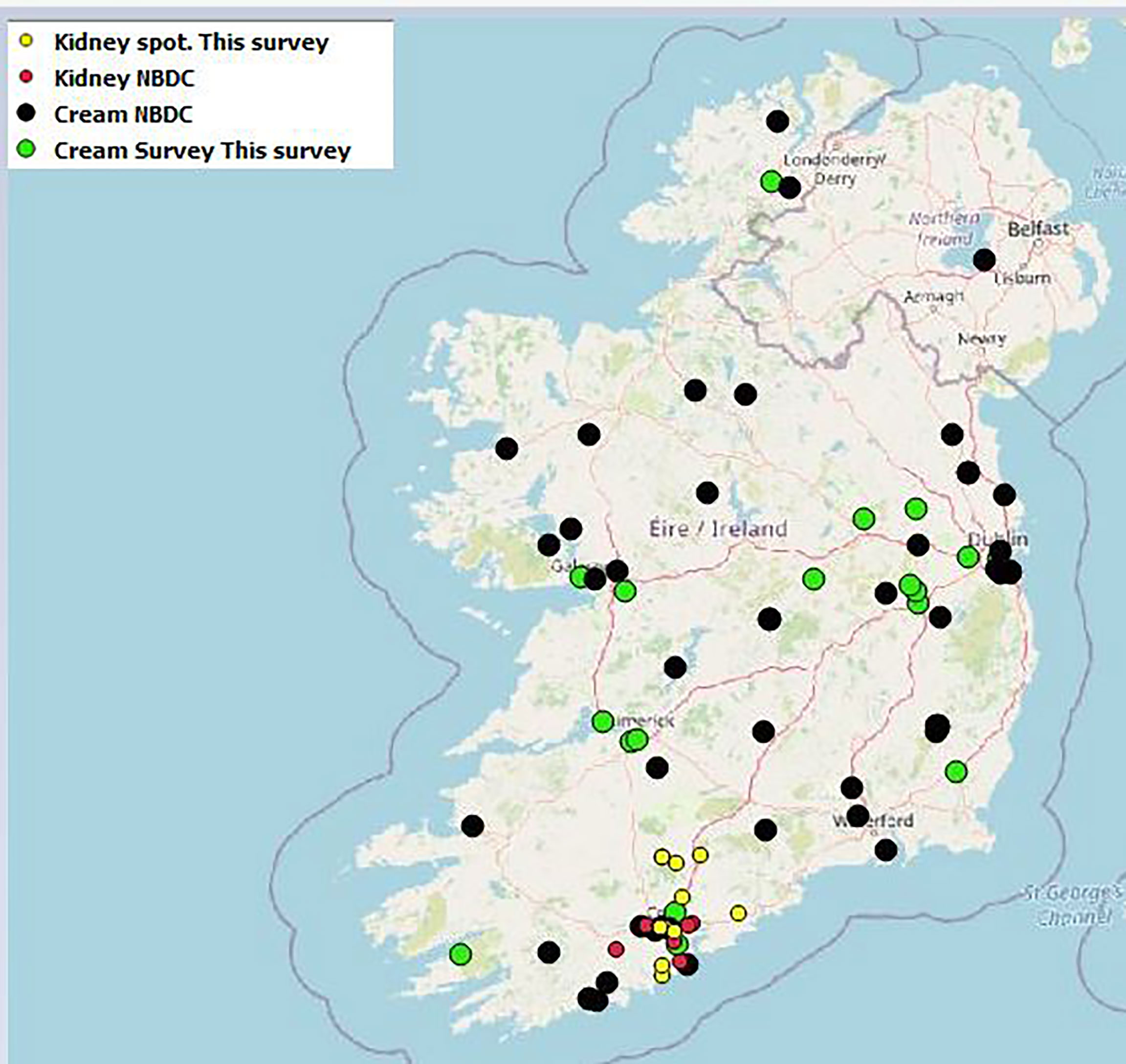
Figure 4 Distribution of Chilocorus renipustulatus and Calvia quatuordecimguttata between April 2020 and June 2021.
Discussion
A considerable number of records were submitted as a result of a citizen science campaign in Ireland that ran for more than 15 months. There was a temporal trend in the submission of the records with a peak in late spring-early summer both years, with the emergence of ladybirds early in the year. Temporal trends have been observed by other citizen science research (Angelidou et al., 2022; (Knape et al., 2022) and attributed by (Kawakami et al., 2016) to predator and prey trends.
The pattern of human settlement across the country is reflected in the geographic distribution of records, with the majority of records submitted from small areas with large human populations. Most records were submitted from the two largest cities in Ireland, Cork, and Dublin. Nearly two-thirds of the Irish population live in urban areas (Central Statistics Office, 2021b; World Population Review, 2021) and the trend towards urbanisation of land in Ireland is among the highest in Europe, yet the proportion of urban to rural land cover remains at just below 2% (Ahrens and Lyons, 2019). The current finding that most records came from areas of high human populations is reflected within citizen science research (Ward, 2014; Geldman et al., 2016; Holden, 2017). Other research where citizen science has been used for ladybirds has revealed similar observations; records are higher in densely populated urban areas (Steenberg and Harding, 2009; Brown et al., 2018; Werenkraut et al., 2020)
Rocha et al. (2018) studied the relationship between aphids and ladybirds in urban gardens and concluded that increases in urban land cover do not favour ladybirds as urban garden habitats. There continues to be large gaps in data relating to our knowledge of the distribution and habitats of many species, and increased numbers of records in highly populated urban areas will give information on the distribution of only a small number of species (Howe et al., 2016).
Surveys on rural habitats are not common. Distribution maps created from other larger citizen science surveys, such as the UK Ladybird Survey with currently over 48,510 records (Brown et al., 2018). Recording of ladybirds in Ireland is a relatively recent activity and, while numbers have increased since the launch of the National Biodiversity Data Centre in 2007, the current survey has shown there are some species of ladybirds that are still under recorded. These include Aphidecta obliterata, Chilocorus renipustulatus, Coccinella hieroglyphica, and Myrrha octodecimguttata that are specialist species, in addition to being smaller in size and less well recognised as ladybirds by the public.
In this study, an increased number of records provided new information on the distribution and abundance of some ladybird species. Coccinella septempunctata was by far the most reported, followed by Harmonia axyridis and Psyllobora vigintiduopunctata. Species such as Chilocorus renipustulatus have been found to be more common in Ireland than anticipated. The first recorded sighting of this species was in Cork in 2011 (Weyman et al., 2019a), and records from the current citizen science campaign have shown its distribution to extend further out into the northern, southern, eastern, and western parts of County Cork. Eleven species of ladybird were recorded during the survey, representing two thirds of the total number of species recorded in Ireland (Table 4) (National Biodiversity Data Centre, pers. comm.). New knowledge relating to ladybirds can indeed be gained from citizen science data (Donnelly et al., 2014; Boakes et al., 2016; Hiller and Haelewaters, 2019; Roche et al., 2021). Although this survey produced a large number of records, the results highlight further gaps in ladybird distribution in Ireland that need to be addressed. The research identified not only spatial biases in a country with a widely spread rural population, but also that participation may reflect the motivation of the population to submit records. Ladybirds, being tiny can often be difficult to observe and this has been suggested to account for higher records of the larger more colorful ladybird species (Callaghan et al., 2019).
The first Irish record for Harmonia axyridis was made in 2007 in Antrim (Murchie et al., 2008). This invasive alien species is now established in Cork, Dublin, and Wexford (O'Sullivan, 2015; Weyman et al., 2019b). The rate of spread of Harmonia axyridis is lower in Ireland and other countries of northern Europe ((Roy et al., 2016), a pattern that could be explained by lower populations and climatic conditions (Roy et al., 2016). Despite a broad adaptability of H. axyridis, here are limitation as to where it can invade (e.g., Soares et al., 2017; Biranvand et al., 2019; Hiller and Haelewaters, 2019).
Social media is an invaluable tool for promoting awareness of topics and dissemination of information and can influence the number and quality of records submitted (Kosmala et al., 2016; Ellwood et al., 2017; Oliveira et al., 2021). Social media platforms are now commonly used for citizen science. Continuous engagement and eye-catching, colorful articles were found to increase the reach and interest from the Facebook posts on the ladybird project pages, a trend also noted by Lukyanenko (2019). Social media can be effective in targeting audiences (Robson et al., 2013) if they have a clear message. The current research found that asking for help to build up knowledge towards the protection of ladybirds resulted in considerable investment from the public. This could also be attributed to the likeability of ladybirds in part (Soares et al., 2022). It is unlikely that as many photographs would have been submitted if the taxonomic subject of the citizen science campaign was less appealing (Callaghan et al., 2019).
It was interesting to note that many of the records (n = 104) included a photo of a ladybird on the arm or hand of a person or child. This familiarity with ladybirds is reflective of the benign attitude that people have towards them. The connectivity between the natural world and humans has been frequently highlighted and ((Jaun-Holderegger et al., 2021) attributes this to experience and teaching of children by family members. Humans, especially children, clearly identify with ladybirds. There is a fascination with ladybirds due to their colour, importance in the garden for predating on plant pests and that the ladybird is associated with good luck in many myths and legends (Roy et al., 2013; (Majerus et al., 2017). There is undoubtedly more to be discovered about why people like ladybirds, and to explain why they are recognised, as a charismatic and popular species (Roy et al., 2013; Majerus, 2017; Soares et al., 2022).
Photographs are perceived as an invaluable analytical tool for collecting data (Catlin-Groves, 2012), and can be important for identifying species for research on estimating distribution (Suzuki-Ohno et al., 2027). Photographs from the 924 records were assessed for their ability to identify ladybirds and a classification system was used to establish their usefulness. Photos were found to be sometimes valuable in identifying ladybirds but did not always reflect the background characters required to identify the habitat or species of plant on which the ladybird was resting. Information on the immediate surrounding may be useful, e.g., wildflower areas, artificial substrates, et cetera. However, photographs submitted by the public were more often than not of little use in providing accurate substrate or habitat information. Citizen science has emerged as a useful tool for collecting data that are not otherwise recorded (Conrad et al., 2011). Verification of records using photographs is an important essential part of citizen science (Silvertown, 2009). Gardiner et al. (2012) suggested that the larger number of samples collected through direct citizen science may compensate for reduced accuracy depending on the types of data collected, but with clear identifiable photographs that can improve accuracy (Comont and Ashbrook, 2017). Citizen science-based research can also reveal sightings of invasive species which were previously unnoticed and provide valuable information where resources may be limited (Grez et al., 2016; Hiller and Haelewaters, 2019).
Conclusions
Citizen science is undoubtedly a useful tool in increasing our knowledge of ladybird distribution. Ladybirds are charismatic species and the public readily engages in providing information on these species. However, this study demonstrated that data provided by the public in response to a non-targeted social media campaign was predominantly urban in origin and centred on large cities resulting in a geographic bias in submitted records. While additional records extended the known distribution of some seldom recorded species, this citizen science campaign did not contribute records of ladybirds from across large areas of the country or from common habitats outside of cities. A substantial increase in effort is required to acquire the data that will fill these knowledge gaps.
Data Availability Statement
The datasets presented in this article are not readily available because of privacy concerns. Requests to access the datasets should be directed to the corresponding author, MTEyMTQ2ODU0QHVtYWlsLnVjYy5pZQ==.
Author Contributions
GW designed the survey, undertook data collection, analyzed data and drafted the manuscript. FB assisted in the drafting and revision of the manuscript. SM provided research facilities. All authors contributed to the article and approved the submitted version.
Funding
This research was funded by the Irish Research Council Enterprise Partnership Scheme (Postgraduate) and the Fota Wildlife Park.
Conflict of Interest
The authors declare that the research was conducted in the absence of any commercial or financial relationships that could be construed as a potential conflict of interest.
Publisher’s Note
All claims expressed in this article are solely those of the authors and do not necessarily represent those of their affiliated organizations, or those of the publisher, the editors and the reviewers. Any product that may be evaluated in this article, or claim that may be made by its manufacturer, is not guaranteed or endorsed by the publisher.
Acknowledgments
The authors would like to thank the staff at Fota Wildlife Park for their support with the research, Dr. Ruth Ramsay (University College Cork) for help with the manuscript, and the many members of the public who gave their time to send in photographs of ladybirds.
References
Ahrens A., Lyons S. (2019). Changes in Land Cover and Urban Sprawl in Ireland From a Comparative Perspective Over 1990–2012. Land 8, 16. doi: 10.3390/land8010016
Ambrose-Oji B., van der Jag A. P. N., O’Neil S. (2014) Citizen Science: Social Media as a Supporting Tool. Available at: https://cdn.forestresearch.gov.uk/2022/02/social_media_support_citizen_science_april_2014-1.pdf (Accessed May 29, 2022).
Angelidou I., Demetriou J., Christou M., Koutsoukos E., Kazilas C., Georgiades P., et al. (2022). Establishment and Spread of the Invasive Ladybird Harmonia Axyridis (Coleoptera: Coccinellidae) in Greece: Based on Contributions From Citizen Scientists. ResearchSquare 1, 1–13. doi: 10.21203/rs.3.rs-1276247/v1
Biranvand A., Nedvěd O., Tomaszewska W., Al Ansi A. N., Fekrat L., Haghghadam Z. M., et al. (2019). The Genus Harmonia (Coleoptera, Coccinellidae) in the Middle East. Acta Ent. Mus. Nat. Pra. 59, 163–170. doi: 10.2478/aemnp-2019-0014
Boakes E. H., Gliozzo G., Seymour V., Harvey M., Smith C., Roy D. B., et al. (2016). Patterns of Contribution to Citizen Science Biodiversity Projects Increase Understanding of Volunteers’ Recording Behaviour. Sci. Rep. 6, 33051. doi: 10.1038/srep33051
Bonney R., Phillips T. B., Ballard H. L., Enck J. W. (2016). Can Citizen Science Enhance Public Understanding of Science? Public Underst. Sci. 25, 2–16. doi: 10.1177/0963662515607406
Brown P. M. J., Adriaens T., Bathon H., Cuppen J., Goldarazena A., Hägg T., et al. (2007). Harmonia Axyridis in Europe: Spread and Distribution of a non-Native Coccinellid. BioControl 53, 5–21. doi: 10.1007/s10526-007-9132-y
Brown P. M. J., Roy D. B., Harrower C., Dean H. J., Rorke S. L., Roy H. E. (2018). Spread of a Model Invasive Alien Species, the Harlequin Ladybird Harmonia Axyridis in Britain and Ireland. Sci. Data 5, 180239. doi: 10.1038/sdata.2018.239
Callaghan C. T., Rowley J. J., Cornwell W. K., Poore A. G., Major R. E. (2019). Improving Big Citizen Science Data: Moving Beyond Haphazard Sampling. PloS Biol. 17, e3000357. doi: 10.1371/journal.pbio.3000357
Central Statistics Office (2021a) Census 2016 Small Area Population Statistics. Available at: https://www.cso.ie/en/census/census2016reports/census2016smallareapopulationstatistics/ (Accessed May 30, 2022).
Central Statistics Office (2021b) Urban and Rural Life in Ireland 2019. Available at: https://www.cso.ie/en/releasesandpublications/ep/p-urli/urbanandrurallifeinireland2019/introduction/ (Accessed May 30, 2022).
Comont R. F., Ashbrook K. (2017). Evaluating Promotional Approaches for Citizen Science Biological Recording: Bumblebees as a Group Versus Harmonia Axyridis as a Flagship for Ladybirds. BioControl 62, 309–318. doi: 10.1007/s10526-016-9771-y
Conrad C. C., Hilchey K. G. (2011). A Review of Citizen Science and Community-Based Environmental Monitoring: Issues and Opportunities. Environ. Monit. Assess. 176, 273–291. doi: 10.1007/s10661-010-1582-5
Catlin-Groves C. L. (2012). The Citizen Science Landscape: From Volunteers to Citizen Sensors and Beyond. Int. J. Zool 2012, 1–4. doi: 10.1155/2012/349630
Davis E., Caffrey J. M., Coughlan N. E., Dick J. T., Lucy F. E. (2018). Communications, Outreach, and Citizen Science: Spreading the Word About Invasive Alien Species. Manage. Biol. Invasions. 9, 515–525. doi: 10.3391/mbi.2018.9.4.14
Donnelly A., Crowe O., Regan E., Begley S., Caffarra A. (2014). The Role of Citizen Science in Monitoring Biodiversity in Ireland. Int. J. Biometeorol. 58, 1237–1249. doi: 10.1007/s00484-013-0717-0
Miller-Rushing A. J. (2017). Citizen Science and Conservation: Recommendations for a Rapidly Moving Field. Biol. Conserv. 208, 1–4. doi: 10.1016/j.biocon.2016.10.014
Fagan M. (2020) More Adults Walking and Exercising Despite Pandemic, Survey Reveals (Irish Examiner). Available at: https://www.irishexaminer.com/news/arid-30996975.html (Accessed May 29, 2022).
Ferster C., Nelson T., Laberee K., Vanlaar W., Winters M. (2017). Promoting Crowdsourcing for Urban Research: Cycling Safety Citizen Science in Four Cities. Urban. Sci. 1, 21. doi: 10.3390/urbansci1020021
Fota Wildlife Park (2022) Fota Wildlife Park Facebook Page. Available at: https://www.facebook.com/FOTAWILDLIFE (Accessed May 29, 2022).
Gardiner M. M., Allee L. L., Brown P. M., Losey J. E., Roy H. E., Smyth R. R. (2012). Lessons From Lady Beetles: Accuracy of Monitoring Data From US and UK Citizen-Science Programs. Front. Ecol. Environ. 10, 471–476. doi: 10.1890/110185
Geldman J., Heilmann-Clausen J., Holm T. E., Levinsky I., Markussen B. O., Olsen K., et al. (2016). What Determines Spatial Bias in Citizen Science? Exploring Four Recording Schemes With Different Proficiency Requirements. Divers. Distrib. 22, 1139–1149. doi: 10.1111/ddi.12477
Grez A. A., Zaviezo T., Roy H. E., Brown P. M. J., Bizama G. (2016). Rapid Spread of Harmonia Axyridis in Chile and its Effects on Local Coccinellid. Divers. Distrib. 22, 982–994. doi: 10.1111/ddi.12455
Haklay M. (2013). “Citizen Science and Volunteered Geographic Information: Overview and Typology of Participation,” in Crowdsourcing Geographic Knowledge. Eds. Sui D., Elwood S., Goodchild M. (Dordrecht: Springer), 105–122.
Hiller T., Haelewaters D. (2019). A Case of Silent Invasion: Citizen Science Confirms the Presence of Harmonia Axyridis (Coleoptera, Coccinellidae) in Central America. PloS One 14, e0220082. doi: 10.1371/journal.pone.0220082
Holden A. D. (2017). Organizing Rural Communities for Effective Citizen Science Programs (University of Montana: Master Thesis. Missoula).
Howe A. G., Ravn H. P., Pipper C. B., Aebi A. (2016). Potential for Exploitative Competition, Not Intraguild Predation, Between Invasive Harlequin Ladybirds and Flowerbugs in Urban Parks. Biol. Invasions. 18, 517–532. doi: 10.1007/s10530-015-1024-y
Jaun-Holderegger B., Lehnert H. J., Lindemann-Matthies P. (2021). How Children Get to Know and Identify Species. Eurasia. J. Math. Sci. Technol. 18, em2061.18. doi: 10.29333/ejmste/11443
Kawakami Y., Kazuo Y., Ohashi K. (2016). Population Dynamics, Seasonality, and Aphid Prey of Cheilomenes Sexmaculata (Coleoptera: Coccinellidae) in an Urban Park in Central Japan. Eur. J. Entomol. 113, 192–199. doi: 10.14411/eje.2016.023
Knape J., Coulson S. J., van der Wal R., Arlt D. (2022). Temporal Trends in Opportunistic Citizen Science Reports Across Multiple Taxa. Ambio 51, 183–198. doi: 10.1007/s13280-021-01550-w
Kosmala M., Wiggins A., Swanson A., Simmons B. (2016). Assessing Data Quality in Citizen Science. Front. Ecol. Environ. 14, 551–560. doi: 10.1002/fee.1436
Kruger L. E., Shannon M. A. (2000). Getting to Know Ourselves and Our Places Through Participation in Civic Social Assessment. Soc Nat. Resour. 13, 461–478. doi: 10.1080/089419200403866
Losey J. E., Jordan E., Perlman E., Hoebeke R. (2007). Citizen Scientist Rediscovers Rare Nine-Spotted Lady Beetle, Coccinella Novemnotata, in Eastern North America. J. Insect Conserv. 11, 415–417. doi: 10.1007/s10841-007-9077-6
Lukyanenko R. (2019). “Citizen Science 3.0: A Vision for the Future of Digital Citizen Science”, in Proceedings of International Conference on IT and Computer Science (London: ICITCS – 2019), 1–4.
Majerus M. (2017). A Natural History of Ladybird Beetles (Cambridge, UK: Cambridge University Press). doi: 10.1017/CBO9781316336960
Matutini F., Baudry J., Pain G., Sineau M., Pithon J. (2021). How Citizen Science Could Improve Species Distribution Models and Their Independent Assessment. Ecol. Evol. 11, 3028–3039. doi: 10.1002/ece3.7210
Mazumdar S., Ceccaroni L., Piera J., Holker F., Berre A. J., Arrlinghaus R., et al. (2018). Citizen Science Innovation in Open Science, Society, and Policy (London: University College London Press).
McKinley D. C., Miller-Rushing A. J., Ballard H. L., Bonney R., Brown H., Cook-Patton S. C., et al. (2017). Citizen Science can Improve Conservation Science, Natural Resource Management, and Environmental Protection. Biol. Conserv. 208, 15–28. doi: 10.1016/j.biocon.2016.05.015
Murchie A. K., Moore J. P., Moore G. A., Roy H. E. (2008). The Harlequin Ladybird (Harmonia Axyridis (Pallas)) (Coleoptera: Coccinellidae), Found in Ireland. Ir. Nat. J. 29, 25–26.
Newcomer K., Tracy B. M., Chang A. L., Ruiz G. M. (2019). Evaluating Performance of Photographs for Marine Citizen Science Applications. Front. Mar. Sci. 6. doi: 10.3389/fmars.2019.00336
O'Sullivan J. (2015). A Breeding Site for the Harlequin Ladybird (Harmonia Axyridis (Pallas)) (Coleoptera: Coccinellidae) in County Cork. Ir. Nat. J. 34, 72–77.
Oliveira S. S., Barros B., Pereira J. L., Santos P. T., Pereira R. (2021). Social Media Use by Citizen Science Projects: Characterization and Recommendations. Front. Environ. Sci. 9. doi: 10.3389/fenvs.2021.715319
Robson C., Hearst M., Kau C., Pierce J. (2013). “Comparing the Use of Social Networking and Traditional Media Channels for Promoting Citizen Science,” in Proceedings of the 2013 Conference on Computer Supported Cooperative Work (New York: NY: ACM Press), 1463–1468. doi: 10.1145/2441776.2441941
Rocha E. A., Souza E. N., Bleakley L. A., Burley C., Mott J. L., Rue-Glutting G., et al. (2018). Influence of Urbanisation and Garden Plants on the Diversity and Abundance of Aphids and Their Ladybird and Hoverfly Predators. Eur. J. Entomol. 115, 140–149. doi: 10.14411/eje.2018.013
Roche J., Nί Shuilleabhain A., Mooney P., Barber G. L., Bell L., Ryan C. (2021). Citizen Science in Ireland. Front. Commun. 6. doi: 10.3389/fcomm.2021.629065
Roy H. E., Brown P. M. J., Adriaens T., Berkvens N., Borges I., Clusella-Trullas S., et al. (2016). The Harlequin Ladybird, Harmonia Axyridis: Global Perspectives on Invasion History and Ecology. Biol. Invasions. 18, 997–1044. doi: 10.1007/s10530-016-1077-6
Roy H. E., Brown P. M. J., Comont R. F., Poland R. L., Sloggett J. J. (2013). Ladybirds, 2nd Edition. Naturalists' Handbook 10 (Exeter: UK: Pelagic Publishing).
Roy H., Brown P., Frost R., Poland R. (2011). Ladybirds (Coccinellidae) of Britain and Ireland (Swindon: UK: Natural Environment Research Council).
Silvertown J. (2009). A New Dawn for Citizen Science. Trends Ecol. Evol. 24 (9), 467–471. doi: 10.1016/j.tree.2009.03.017
Soares A. O., Haelewaters D., Ameixa O. M. C. C., Borges I., Brown P. M. J., Cardoso P, et al. (2022). A Roadmap for Ladybird Conservation and Recovery. Conserv. Biol.
Soares A. O., Honěk A., Martinkova Z., Skuhrovec J., Cardoso P., Borges I. (2017). Harmonia Axyridis Failed to Establish in the Azores: The Role of Species Richness, Intraguild Interactions and Resource Availability. BioControl 62, 423–434. doi: 10.1007/s10526-017-9794-z
Stals R., Prinsloo G. (2007). Discovery of an Alien Invasive, Predatory Insect in South Africa: The Multicoloured Asian Ladybird Beetle, Harmonia Axyridis (Pallas) (Coleoptera: Coccinellidae): Research in Action. S. Afr. J. Sci. 103, 123–126.
Steenberg T., Harding S. (2009). The Harlequin Ladybird (Harmonia Axyridis Pallas) in Denmark: Spread and Phenology During the Initial Phase of Invasion. Entomol. Medd. 77, 27–39.
Suzuki-Ohno Y., Yokoyama J., Nakashizuka T., Kawata M. (2017). Utilization of Photographs Taken by Citizens for Estimating Bumblebee Distributions. Sci. Rep. 7 (1), 1–11. doi: 10.1038/s41598-017-10581-x
Terry J. C. D., Roy H. E., August T. A. (2020). Thinking Like a Naturalist: Enhancing Computer Vision of Citizen Science Images by Harnessing Contextual Data. Methods Ecol. Evol. 11, 303–315. doi: 10.1111/2041-210X.13335
Ward D. F. (2014). Understanding Sampling and Taxonomic Biases Recorded by Citizen Scientists. J. Insect Conserv. 18, 753–756. doi: 10.1007/s10841-014-9676-y
Werenkraut V., Baudino F., Roy H. E. (2020). Citizen Science Reveals the Distribution of the Invasive Harlequin Ladybird (Harmonia Axyridis Pallas) in Argentina. Biol. Invasions. 22, 2915–2921. doi: 10.1007/s10530-020-02312-7
Weyman G., Butler F., Whelan P., Fonteneau J., Bourke S., Kane A., et al. (2019a). First Records of the Kidney Spot Ladybird (Chilocorus Renipulstulatus) (Coleoptera, Coccinellidae) in Ireland. Ir. Nat. J. 36, 145–146.
Weyman G., Butler F., Whelan P., McKeown S. (2019b). Establishing the Pattern of Spread of Harlequin Ladybirds in Cork County, Ireland. IOBC. WPRS. Bull. 145, 74–76.
Wiggins A., Crowston K. (2011). “From Conservation to Crowdsourcing: A Typology of Citizen Science,” in 2011 44th Hawaii International Conference on System Sciences (Koloa: HI).
World Population Review (2021) Ireland Population 2022 (Live). Available at: https://worldpopulationreview.com/countries/ireland-population (Accessed May 30, 2022).
Keywords: citizen science, Coccinellidae, social media, distribution, urban
Citation: Weyman G, Butler F and McKeown S (2022) Enhancing Our Understanding of Ladybirds in Ireland – A Case Study of the Use of Citizen Science. Front. Conserv. Sci. 3:759113. doi: 10.3389/fcosc.2022.759113
Received: 15 August 2021; Accepted: 30 May 2022;
Published: 10 August 2022.
Edited by:
Danny Haelewaters, Ghent University, BelgiumReviewed by:
Pedro Segurado, University of Lisbon, PortugalOldřich Nedvěd, University of South Bohemia in České Budějovice, Czechia
Copyright © 2022 Weyman, Butler and McKeown. This is an open-access article distributed under the terms of the Creative Commons Attribution License (CC BY). The use, distribution or reproduction in other forums is permitted, provided the original author(s) and the copyright owner(s) are credited and that the original publication in this journal is cited, in accordance with accepted academic practice. No use, distribution or reproduction is permitted which does not comply with these terms.
*Correspondence: Gill Weyman, bGFkeWJpcmRAZm90YXdpbGRsaWZlLmll
 Gill Weyman
Gill Weyman Fidelma Butler
Fidelma Butler Sean McKeown1
Sean McKeown1